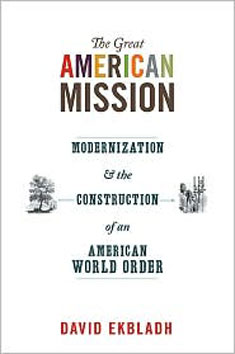Winning Hearts and Minds
From the Philippines to Afghanistan, the U.S. has a long history of using development as a foreign policy tool
By Taylor McNeil
In the aftermath of World War II, the United States spent billions to rebuild Europe and fight the advance of communism. With that assistance, the shattered economies of Western Europe quickly surpassed pre-war levels, keeping the Soviet Union in check.
Fast forward some 60 years. As the United States sends more troops to Afghanistan to battle the Taliban insurgency, it is also spending millions of dollars to develop that impoverished country, building roads, schools and health-care clinics and improving government administration. U.S. officials say that such projects will bolster security and strengthen the beleaguered Afghan government.

“There are people who really believe we can make life better with liberal ideas coming out of the United States—that this is the best way for people to live,” says David Ekbladh. Photo: Joanie Tobin
Though it’s rarely in the public spotlight, developing—or modernizing—poor countries has been a component of U.S. foreign policy for roughly a century, says David Ekbladh, an assistant professor of history in the School of Arts and Sciences. In his new book, The Great American Mission: Modernization and the Construction of an American World Order (Princeton University Press), Ekbladh details how the United States has used development initiatives to combat international threats and assesses the degree to which they have been successful.
The definition of development is broad: it encompasses everything from establishing political institutions to building infrastructure. It is a “continuous ... process of social, economic and political change,” writes Ekbladh. As a foreign-policy tool, it’s the carrot being offered instead of the stick.

The U.S. started on this path in the early 1900s, when it colonized the Philippines. “It was conceptualized as a grand and progressive public works project,” he writes. Then in the 1930s, development came to the forefront of American policy. The free market economies of the U.S. and Europe were in shambles, and competing ideologies—fascism and communism—were gaining momentum.
U.S. policymakers of all stripes agreed that by offering development assistance, they were working toward providing a safer future for all. One of the key figures in the debate was the Tufts economist Eugene Staley, who “projected American fears and the strategic need for international development in the critical years between 1937 and 1941,” Ekbladh writes. The result was the creation of an official foreign aid program—the forerunner of today’s U.S. Agency for International Development—with a global mission.
Consider another example Ekbladh explores in his book: North and South Korea. “It was the clearest point of competition: fraternal socialism in the north versus international liberalism in the south,” he says. “The interesting part of this story is that today we think of North Korea as a basket case—how could it not have been this Orwellian nightmare that it is? But for the Americans, North Korea in the ’50s and ’60s was a success, and was something that was very frightening to them, particularly when their own efforts in South Korea in the late ’50s and early ’60s seemed horribly bogged down.”
Barbarians at the Gate
Following the Korean War, the U.S. funded and led development projects to help move South Korea’s economy ahead of North Korea’s, but it wasn’t easy going. In the end, the Americans had to work with a series of modernizers who, unfortunately, were strongmen.
“The Americans accommodated these guys, even though they didn’t like them,” Ekbladh says. “It’s the classic case of Americans who never like the autocrats—but they work with them because they promise to modernize and keep the communists at bay.”
It was certainly ironic. “The Americans were using liberal developmentalism and talked about grassroots democracy, yet they were very easily accommodating to the shah in Iran, to Park Chung Hee in Korea and to various [autocratic] regimes in Latin America,” he says.
Still, Ekbladh calls these “positively motivated programs.” There are people “who really believe we can make life better with liberal ideas coming out of the United States—that this is the best way for people to live,” he says. “But it’s always being stalked by the negative side: we have to do this or else somebody else will, and if somebody else does it, we’re going to get a future that is nightmarish.”
And many policymakers have watched that happen. “Some of these people had seen where modernity went off the rails and you got Nazi Germany and Stalin’s Russia. This is part of why Americans were eager to do this in the ’50s and ’60s, because they had had an object lesson,” he says. Development was promoted as something that had to be done “because we’ve got these barbarians at the gate, and the barbarians never go away.”
Vietnam and Beyond
That was the tack American policymakers took in Vietnam—the U.S. was fighting a war, propping up autocratic rulers and spending heavily on development projects to win the hearts and minds of the locals.
Although aspects of these programs were successful, overall they failed “because of security, because of a lack of clarity about what was going to be done and because the local regime was confused and weak,” says Ekbladh.
Following Vietnam, the U.S. moved from government-led development programs to the view “that it’s better done by NGOs or by business,” says Ekbladh. He sees a parallel in the political economy: when the world was accepting of laissez-faire free-market policies in the 1980s and 1990s, it’s no wonder that government declined to play a large role in development.
“But the interesting thing is, now that the bottom has fallen out of the laissez-faire free market, will the state be back?” Ekbladh doesn’t profess to know, but is intrigued by the role of the U.S. government in development in Afghanistan and Iraq. “Kicking and screaming, the state in the Bush years took over a central role, and increasingly you see the projects getting bigger and more ambitious because they are connected to a state interest, the U.S. establishing a stable and secure Afghanistan.”
Taylor McNeil can be reached at taylor.mcneil@tufts.edu.


